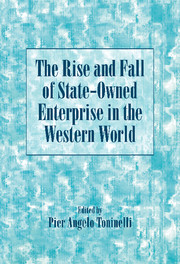Book contents
- Frontmatter
- Contents
- Preface
- Contributors
- PART I SETTING THE STAGE
- PART II NATIONAL CASES
- 5 The Rise and Fall of State-Owned Enterprise in Germany
- 6 Beyond State and Market: Italy's Futile Search for a Third Way
- 7 State Enterprise in Britain in the Twentieth Century
- 8 The Rise and Decline of State-Owned Industry in Twentieth-Century France
- 9 The Rise and Decline of Spanish State-Owned Firms
- 10 Fifty Years of State-Owned Industry in Austria, 1946–1996
- 11 A Reluctant State and Its Enterprises: State-Owned Enterprises in the Netherlands in the “Long” Twentieth Century
- 12 State-Owned Enterprises in a Hostile Environment: The U.S. Experience
- Conclusion: Schumpeter Revisited
- Index
12 - State-Owned Enterprises in a Hostile Environment: The U.S. Experience
Published online by Cambridge University Press: 05 December 2011
- Frontmatter
- Contents
- Preface
- Contributors
- PART I SETTING THE STAGE
- PART II NATIONAL CASES
- 5 The Rise and Fall of State-Owned Enterprise in Germany
- 6 Beyond State and Market: Italy's Futile Search for a Third Way
- 7 State Enterprise in Britain in the Twentieth Century
- 8 The Rise and Decline of State-Owned Industry in Twentieth-Century France
- 9 The Rise and Decline of Spanish State-Owned Firms
- 10 Fifty Years of State-Owned Industry in Austria, 1946–1996
- 11 A Reluctant State and Its Enterprises: State-Owned Enterprises in the Netherlands in the “Long” Twentieth Century
- 12 State-Owned Enterprises in a Hostile Environment: The U.S. Experience
- Conclusion: Schumpeter Revisited
- Index
Summary
For more than a century, American historians have devoted considerable energy to explaining how and why their nation's experience is unique. Self-absorbed and often self-congratulatory, they have sprinkled these historical exercises with moral judgments based on everything from the peculiarities of organized religion in the United States to the wonders of America's modern plumbing. Although this essay on U.S. encounters with state-owned enterprises (SOEs) does not dwell on morality, it perforce deals with the question of uniqueness. My position on that question can be summarized as follows: First, the history of SOEs in the United States has many unique characteristics. Second, when we add municipal and state-level SOEs to those created by the federal government, developments in the United States do not appear to be as unique as many of its citizens have assumed they were. Third, the historical processes that fostered state-owned ventures and also the processes that turned the nation away from them were similar to the processes that shaped the rise and fall of SOEs in the other nations surveyed in this volume. The objectives were similar, and the factors shaping SOE performance were much the same.
We can evaluate these propositions after examining the two distinct cycles or phases of experimentation with SOEs that took place in the United States. The first, relatively short cycle – the developmental phase – took place during the first half of the nineteenth century, when stimulating economic growth provided the primary rationale for state enterprise. During this developmental cycle the difference between the level of SOE investment in the United States and in the leading economic powers of Europe appears not to have been particularly significant.
- Type
- Chapter
- Information
- The Rise and Fall of State-Owned Enterprise in the Western World , pp. 273 - 302Publisher: Cambridge University PressPrint publication year: 2000
- 4
- Cited by

